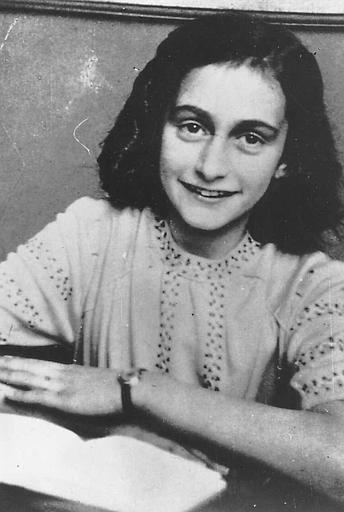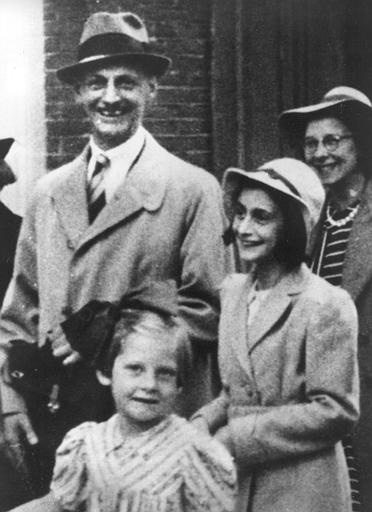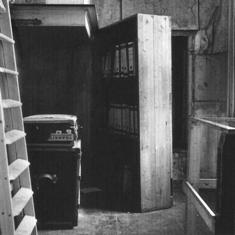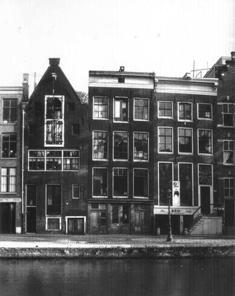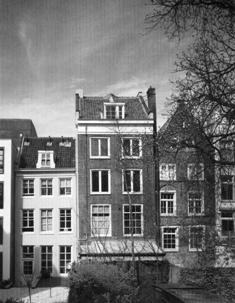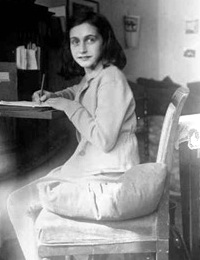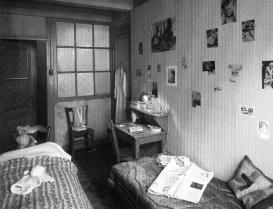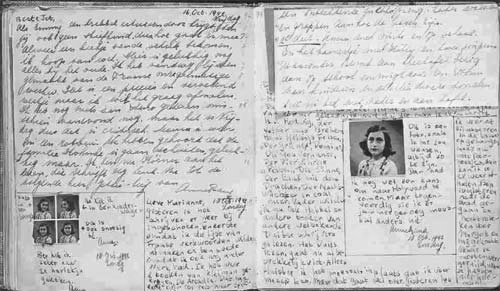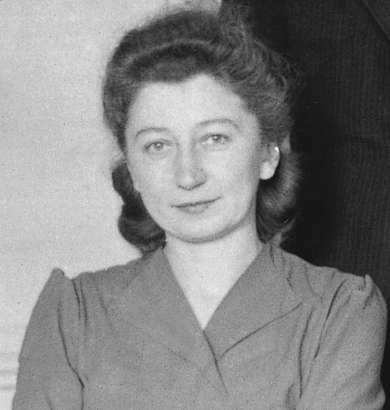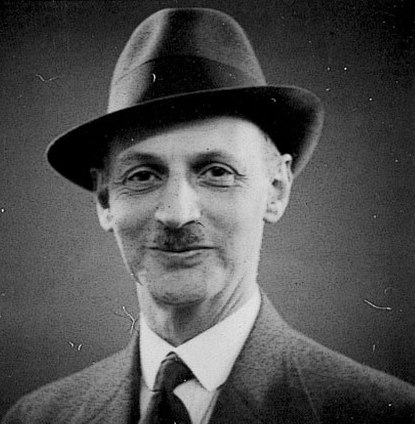Holocaust Education & Archive Research Team |
|
Occupation German Occupation of Europe Timeline
-
[The Occupied Nations]
Poland Austria Belgium Bulgaria Denmark France Germany Greece Hungary Italy Luxembourg The Netherlands Norway Romania Slovakia Soviet Union Sudetenland | ||||||
Anne Frank and Her Family
Ancestors of Anne Frank lived in Frankfurt Germany since the 17th century, Otto Frank, Anne’s father was born on 12 May 1889, in Frankfurt’s Westend, a well-to-do neighbourhood.
Otto Franks father was a banker, Otto attended high school, and briefly studied art at the University of Heideleberg. Via a friend he was then offered and accepted a job from 1908 to 1909 at Macy’s Department Store in New York, USA.
When his father died, Otto Frank returned to Germany and worked for a metal engineering company in Dusseldorf until 1914. During WW-1 he and his two brothers served in the German Army, where Otto attained the rank of lieutenant.
After the war he worked in his father’s bank, but banks did not fare well at that time, however whilst working in the bank he became acquainted with Edith Hollander, the daughter of a local manufacturer.
Born in 1900, she grew up in Aachen, Otto and Edith married in 1925 and settled in Frankfurt, they then have two daughters, Margot born in 1926 and Annelies (more commonly known as Anne), Marie born on 12 June 1929.
In 1933 after Hitler seizes power and anti- Jewish measures are introduced, Otto Frank leaves Frankfurt for Amsterdam. He starts a branch of the German Opteka Company there, and soon Edith, Margot and Anne joined him in Holland.
The Frank family moves into a house on Merwedeplein in the southern part of the city. Anne and Margot attend the nearby Montessori school. They are popular and make lots of friends, as do their parents with other Jewish refugees who settle in the same neighbourhood.
However, the German invasion of Holland on 10 May 1940 soon shatters this carefree life for the population of Holland.
During 1941 the Nazis increased the number of anti-Jewish, and the Franks started to prepare for going into hiding. Thanks to the cooperation of his staff – Miep Gies, Jo Kleiman, Viktor Kugler and Bep Voskuijl, Otto Frank was able to secretly prepare a hiding place for his family, the Van Pels family and others. Mr Van Pels worked at Otto Frank’s company.
On 12 June 1942 Anne celebrated her thirteenth birthday and her parents give her a present of a diary, in her diary she wrote about everything she experienced and felt.
On 5 July 1942 Margot Frank received the dreaded call to report to a labour camp, the next day the Frank family moved into the “Secret Annex,” on 263 Prinsengracht.
On 6 July 1942 Anne was awakened at five-thirty in the morning by her mother, the family dressed in thick layers of clothing. Miep Gies took Margot on a bicycle to the hiding place.
At seven-thirty in the morning the rest of the family went on foot to the “Secret Annex” located behind Otto Frank’s company. One week later Mr and Mrs Van Pels and their son Peter joined the Frank’s in hiding.
Later Fritz Pfeffer joined the other Jews in hiding, and Anne writes in her diary constantly, a few selected passages are recorded as such:
“Our little room looked very bare at first with nothing on the walls, but thanks to Daddy who had brought my film- star collection on beforehand, and with the aid of a paste pot and brush, I have transformed the walls into one gigantic picture. This makes it look much more cheerful.”
11 July 1942
“Countless friends and acquaintances have been taken off to a dreadful fate. Night after night, green and gray military vehicles cruise the streets. It is impossible to escape their clutches unless you go into hiding.”
19 November 1942
“As if I’d seen one of the World’s wonders, I saw two Jews through the curtain yesterday, it was a horrible feeling, just as if I had betrayed them to the authorities and was now watching them in their misery.”
13 December 1942
“A wooden staircase ascends from the floor where the offices are located to the landing in front of the movable bookcase. The helpers use this staircase when they want to go to the “Secret Annexe.”
Kugler comes up the stairs hurry-scurry - a short sturdy knock on the door and in he comes, wringing his hands in proportion to his mood, either good-tempered and boisterous or bad-tempered and silent. “
5 August 1943
Mr Bolkestein the Cabinet Minister, speaking on the Dutch broadcast from London said that after the war, a collection would be made of diaries and letters dealing with the war. Of course everyone pounced on my diary. Just imagine how interesting it would be if I were to publish a novel about the “Secret Annexe.”
The title alone would make people think it was a detective story.”
29 March 1944
“But … there’s someone else who governs all my moods and that’s Peter. Oh he gazes at me with such warmth in his eyes. I don’t think it will take much for me to fall in love with him. In any case, we’re getting to know each other a little better.
I wish we dared to say more. But who knows, maybe that time will come sooner than I think.
Once or twice a day he gives me a knowing glance – I wink back and we’re both happy.”
3 March 1944
“Great commotion in the Annexe, is this really the beginning of the long awaited liberation? The liberation about which so much has been said, but which seems too wonderful, too much like a fairy tale, ever to come true?
Will this year 1944, bring us victory?
We don’t know yet, but where there’s hope, there’s life and this restores our courage and makes us strong again. Margot says that maybe I can even go back to school in October or September.”
6 June 1944
“I see the world gradually being turned into a wasteland. I hear the ever approaching thunder which will destroy us too. I feel the suffering of millions of people and yet, if I look up into the heavens, I somehow feel that all this will come right again, that also this savagery will stop, that there will be peace and tranquillity in the world once again.
Until that time, I must hold onto my ideals. Perhaps the day will come when I’ll still be able to realise them.”
15 July 1944
If I’m watched to that extent, I start by getting snappy, then unhappy and finally I twist my heart round again, so that the bad is on the outside and the good is on the inside, and keep on trying to find a way of becoming what I so would like to be, and what I could be, if , there weren’t any other people living in the world.
1 August 1944
This is the last entry in Anne Frank’s diary.
Three days later on the 4 August 1944 the SD led by the Austrian Karl Joseph Silberbauer, and Dutch – SD detectives Gezinus Gringhuis, and Wilem Grootendorst, following a tip off that Jews were hiding at 263 Prinsengracht.
Otto Frank remembered the moment of discovery and arrest:
“It was around ten-thirty. I was upstairs by the Van Pels’s in Peter’s room and I was helping him with his schoolwork. I didn’t hear anything. And when I did hear something, I didn’t pay any attention to it. Peter had just finished an English dictation and I had just said “But Peter, in English double is spelled with only one b.”
I was showing him the mistake in the dictation when suddenly someone came running up the stairs. The stairs were squeaking, I stood up, because it was still early in the morning and everyone was supposed to be quiet – then the door opened and a man was standing right in front of us with a gun in his hand and it was pointed at us. The man was in plain clothes.
Peter and I put up our hands. The man had us walk in front of him and ordered us to go downstairs, and he walked behind us with the pistol. Downstairs everyone was gathered.
My wife, the children, the Van Pels’s stood there with their hands in the air. Then Pfeffer came in, and behind him were still more strangers. In the middle of the room there was someone from the Grune Polizei, he was studying our faces.”
Miep Gies also recalled the events of the 4 August 1944:
“Later I heard everyone coming downstairs, very slowly. They had been able to pack in the meantime. I wasn’t allowed to go to the window. I had to stay in my seat. And I did that. Afterwards Bep and I went upstairs to the bedroom of the Franks. And there we saw Anne’s diary lying on the ground. “Let’s pick it up,” I said.
Because Bep stood there looking around in a daze. I said, “Pick it up, pick it up, lets get out of here,” because we were so frightened. In 1948 the police conducted an initial investigation into the betrayal and arrest of those in hiding. Willem van Maaren was one of the suspects. Van Maaren categorically denied any involvement in the betrayal.
On 4 August 1944 a vehicle carrying ten prisoners, the eight people in hiding and two male helpers, drives to the SD Bureau on Euterpestraat in Amsterdam. After a short stay in another prison Kleiman and Kugler are transferred to Amersfoort Police Transit Camp.
Those in hiding were kept in the House of Detention on Weteringschans in Amsterdam from 5-8 August 1944. Early in the morning of 8 August 1944 they were taken to the central train station and from there to the transit camp at Westerbork. On 3 September 1944 the 83rd Judentransport left Westerbork for Auschwitz, this was the last transport from Westerbork to Auschwitz, there were 1019 people on this train 498 men, 442 women, and 79 children.
Otto Frank recalls the arrival of his family at Auschwitz in 1979:
“I can no longer talk about how I felt when my family arrived on the train platform in Auschwitz and we were forcibly separated from each other.”
The fate of those arrested was mostly tragic. Herman van Pels was gassed in Auschwitz – exact date unknown. Auguste van Pels died either in Theresienstadt or on the way there in April or May 1945. Peter van Pels died in Mauthausen after leaving Auschwitz, on 5 May 1945, the day the camp was liberated.
Fritz Pfeffer died in Neuengamme’s sick-bay barrack on 20 December 1944. Edith Frank died on 6 January 1945 in the sick-bay at Auschwitz- Birkenau.
At first Margot Frank is together with her sister and mother in Auschwitz. With the Soviets advancing through Poland, the Nazis deport able bodied Jews to the Reich. Margot and Anne Frank were selected to be transported to Bergen- Belsen, and leave Auschwitz either in late October 1944 or early November 1944.
The conditions in Bergen- Belsen were dreadful with diseases running rampant, in March 1945 Margot died of typhus, as does Anne Frank also in March 1945. Otto Frank endured several months of heavy labour in one of Auschwitz’s outdoor commandos, before becoming ill. Otto was too weak to be evacuated on the death marches, but was liberated in the sick-bay barrack by Soviet forces on 27 January 1945.
Upon his return to Amsterdam, Otto Frank realises he is the only survivor of his family, and Miep Gies gives to him Anne’s papers and writings, that she rescued from the Annex. Friends persuade Otto Frank to publish Anne’s diary, “The Diary of Anne Frank” appears in 1947 under the title “Het Achterhuis” (The Annex). To date, more than fifty different editions have appeared, and more than 18 million copies have been sold.
In 1953 Otto Frank married Elfriede Markovits, also a survivor of Auschwitz. They settle in Basel, Switzerland, and Otto Frank died in Basel in August 1980, at the age of 91.
Sources:
Anne Frank in the World – Anne Frank Stichting – Amsterdam June 1985. Anne Frank House – A Museum with a Story – Anne Frank House Amsterdam. The Diary of Anne Frank – published by MacMillan Children’s Books London 1995. Holocaust Historical Society
Copyright Harald Neilsen H.E.A.R.T 2007
|
